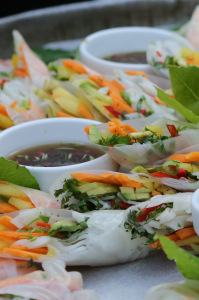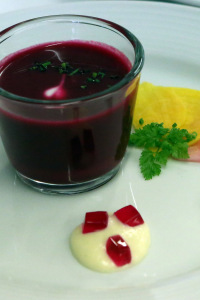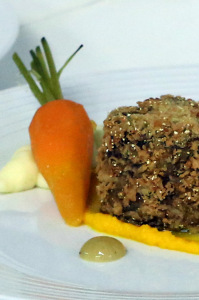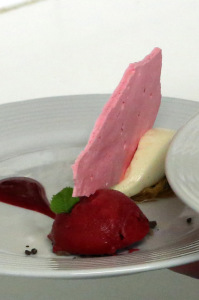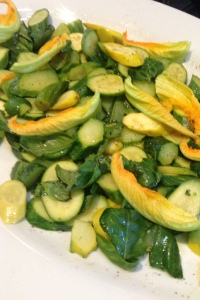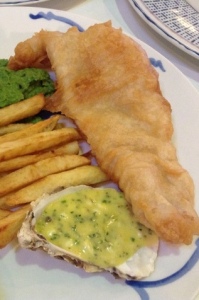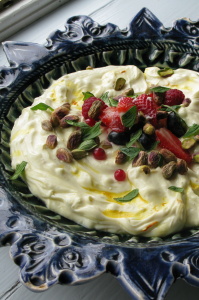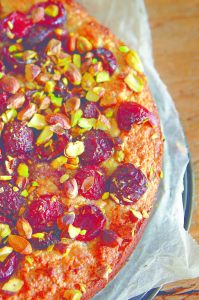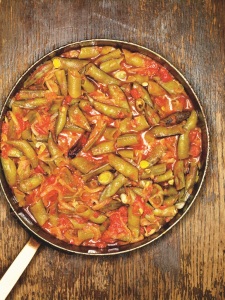It’s become a bit of a tradition at the Ballymaloe Cookery School for the students to do a fundraiser during the term to support the East Cork Slow Food Education Project. We’ve had all kinds of events including a sponsored foraging walk over the cliffs at Ballycotton, and a pub quiz in the Blackbird. In recent times, a Pop Up dinner in the Garden Cafe at the Cookery School has been the most popular choice also chosen by this term’s students. Their theme was ‘A Midsummer Night’s Feast’. They drew up exciting and elaborate plans, divided the work between them and for the past few weeks they have been researching, planning and testing with youthful enthusiasm and terrific gusto. They read Shakespeare’s classic play, A Midsummer Night’s Dream several times over – and an Indian student from Mumbai read passages from the play at intervals during the meal in his charmingly dramatic way.
They planned the menu – incorporating as many fresh local foods as they could and seasonal produce from the farm, gardens and greenhouse. The succulent lamb for the main course came from Frank Murphy’s butcher shop in Midleton. They even picked the organic rose petals from the water garden and dried them for the spectacular dessert.
On Saturday and all of Sunday they worked with military precision. The teams were cooking all day having loads of fun. The bread makers started at 5.30 am on Sunday and made four lovely breads which were served with Jersey butter  fresh from the dairy.
They hung beech leaves and wild clematis from the rafters and did a paper installation that looked like fluttering birds over the doorway. The design team chose to transform the dining room into a midsummer forest scene and went off foraging round the gardens to find all sorts of summer foliage and blossoms.
Three long tables were laid with starched white linen table cloths. They had fresh banana leaves from the greenhouse down the centre as a runner topped with mossy logs wound round with the creamy white fragrant blossoms of philadelphus – mock orange – which scented the air so beautifully.
The Strawberry and Mint Cocktail and a Passion Fruit and Mango Non-Alcoholic Cocktails were both irresistible and they made a beautiful ice bowl full of roses to hold the ice.
Candles and twinkling night lights were lit in the conservatory and a student played the piano serenading the guests as they arrived. A Swedish student where midsummer night is a traditional celebration, had shown some other students how to make little herb and flower wreaths for the waitress’s hair.
The delicious canapés created set the scene: Smoked Salmon with Cream Cheese and Cucumber; Indian Spiced Potato Cakes with Mint and Yoghurt Raita and Vietnamese Spring Rolls with Tamari Dipping Sauce got an overwhelmingly positive response and there were gasps of admiration when the guests saw the transformation of the Cafe.
The beautiful summer starter incorporated beetroot in three ways: Chilled Beetroot Soup, Beetroot Carpaccio and Beetroot Jelly and Sour Cream.
The main course was the culmination of much thought and experimentation. Slow Roasted Shoulder of Lamb with Carrot Puree, Mashed Potato and an Apple and Mint Gel. It was much enjoyed; I’ve rarely seen so many plates with not a morsel left behind
The desserts Feta and Honey Cheesecake, Raspberry Spuma, Chocolate Soil and Meringue Shards… got compliments from every table.
All the students had been invited to enter a competition for the best midsummer night’s dream confection – it had to have some kind of flower connection – meringue lollipops, chocolate bark, rose petal cake, tarts and cupcakes there was scarcely a rose left in the garden after the event!
Some of the students had done a little cooking before they came to the school, a few having worked in professional kitchens. But many had scarcely made toast before they joined us 10 weeks ago – so we were bursting with pride at what they had achieved, having done all the planning and cooking, themselves, a view shared by the guests. They created a truly magical and memorable evening, a huge thank you to all involved.
Hot Tips
Great News! Ramen has opened its latest restaurant in Midleton. John Downey a past Ballymaloe Cookery School student and his chain of restaurants serving Thai food fast have been a great hit in Cork. Now he’s expanding again to Midleton’s Distillery Lane. Make sure to check it out if you are nearby www.ramen.ie
Roof Top Popups By the Creatives
Event stylist Jette Virdi and chef Johan van de Merwe love connecting people to each other and to their surroundings through the medium of food. In a new project taking place in late summer 2015, the pair are inviting Dubliners to see their city from a different perspective through a series of rooftop dinners.
Over the last three weekends of August 2015, Jette and Johan will combine their skills and take over three rooftops around the city. Jette will create a bespoke design for each venue whilst Johan will wow diners with a menu that reflects the best of local produce. Welcomed by cocktails crafted by Anna Walsh (Irish Bartender Champion 2015), guests will then be taken through a wonderful 4 course dinner all for €45.
Join Jette and Johan on the following dates:
14+15 August
21+22 August
28+29 August
Tickets @ €45 per person
Tickets: form Eventbrite Roof Top Popups
http://www.foodstyle.ie and jettevirdi.com
Date for your Diary
Head for beautiful Donegal on the Wild Atlantic Way. The Donegal Food Festival runs from August 28th-30th, lots of cookery demos, cook offs, tastings, cheese masterclass, menu planning, seaweed masterclass….and lots lots more
http://www.atasteofdonegal.com/
Chilled Ruby Beetroot Soup with Beetroot Carpaccio
The students served this soup in small bowls with slivers of raw beetroot, a beetroot jelly made from the beetroot pickling liquid and sour cream.
Serves 8
800g (1 3/4lb) whole beetroot
225g (8oz) chopped onions
50g (2oz/1/2 stick) butter
salt, pepper and sugar
approx 1.2 litre (2 pints/5 cups) of light chicken stock
150ml (5fl oz/generous 1/2 cup) pouring cream
300ml (10 fl oz/1 1/4 cups) natural, unsweetened yoghurt
4 tablespoons (5 American tablespoons) of chopped chives and chive flowers if available
Wash the beets under a cold running tap with your hands being careful not to break the skin. Leave the little tail on and about 5cm (2 inches) of the stalks intact so as not to allow the beets to bleed.
Place in a saucepan that they fit snugly into and cover with boiling water. Add a pinch of salt and sugar. Cover, bring to the boil and simmer until the beets are cooked. The cooking time depends on the size and they can take anything from 20 minutes for tiny little beets to 2 hours for larger ones. They are cooked when the skin rubs off really easily. Don’t use a knife to test if they are cooked, as this will also cause bleeding.
While the beets are cooking, melt the butter and allow to foam. Add the onions, coat in the butter, cover tightly and sweat very gently until soft, tender and uncolored.
When the beets are cooked, peel, chop coarsely and add to the onions.
Add just enough boiling chicken stock to cover and season with salt, pepper and a pinch of sugar. Bring to a boil and simmer for just 1 minute.
Now purée to achieve a smooth and silky consistency. Allow to cool completely. Add yoghurt and a little cream to taste. Check seasoning adding a little sugar if necessary.
Serve chilled with a swirl of yoghurt and lots of chopped chives and a few chive flowers if available.
Â
Meringue Lollipops
Makes 8-10
4 egg whites
8 ozs (225g/generous 1 cup) castor sugar
Naural pink food colouring
Flat timber lollipops sticks
1-2 teaspoons Rosewater (optional)
Preheat the oven to 110°C\225°F\regulo ¼.
Put the egg whites into a spotlessly clean bowl of a food mixer. Break up with the whisk and then add all the castor sugar in one go. Whisk at full speed until it holds a stiff peak 4 – 5 minutes approx. Add a few drops of colouring and rosewater to taste (strength – varies, depending on the brand). Stir carefully to mix.
Meanwhile line 1 or 2 baking trays with parchment paper.   Lay the lollipop sticks well apart on the tray, pipe a solid circle of meringue about 12 mm in diameter on top.
Bake in the preheated oven for 30-40 minutes or until they can lift easily off the parchment paper. Â Â Allow the meringue lollipops to cool on the trays.
Serve with a bowl of cream.
John Pollard’s Potato and Buttermilk Dinner Rolls
Makes 30 x 90g (3 1/2oz) dinner rolls
350g (12oz) of riced steamed potatoes (a floury type of potato is best – Golden Wonder or Yukon Gold)
150g (5oz/1 1/4 sticks) soft butter
425ml (15fl oz/scant 2 cups) whole-milk buttermilk (37°C/99°F)
1 tablespoon (1 American tablespoon + 1 teaspoon) of castor sugar
1 tablespoon (1 American tablespoon + 1 teaspoon) of best quality honey
2 large eggs (room temperature)
3 teaspoons of salt
18g (3/4oz) dry yeast
880g (1lb 15oz/scant 8 cups) strong white flour (bread flour; will require the addition of more flour (up to 220g (7 3/4oz/scant 2 cups) depending on the type of potato used and humidity of day)
Boil or steam the potatoes until soft, peel and push through a ricer.
Transfer into the bowl of a mixer. Add softened butter which will melt into the warm potatoes as you mix with a dough hook for 1-2 minutes.
Meanwhile, warm the buttermilk to 37°C/99°F, add to the potato.
With the machine running, add 2 large eggs, 1 tablespoon of castor sugar, 1 tablespoon of honey and 3 teaspoons of salt.
Add the dry yeast to the mixture and continue to knead for 1-2 minutes.
Allow to stand for 5 minutes and then gradually mix in 880g of strong white flour using dough hook. Add additional flour until the dough comes away clean from the mixing bowl (dough will be moist and will not clean completely from bowl surface depending on the type of potato used).
Continue to knead dough by hand, adding additional flour if necessary. Dough will be silky soft and light when hand kneading is finished (approximately 7 – 10 minutes).
Return the dough to a lightly oiled food mixer bowl and cover with cling film.
Allow to rise to double the original volume at room temperature (1 – 1 1/2 hours).
Deflate dough and shape into well formed 90g (3 1/2oz) rolls. Arrange on a buttered pan leaving approximately 2-4mm (1/8 – 1/4 inch) between the rolls to allow for rising.
Allow to rise into a continuous pan of rolls over a 1 1/2 hour period (rolls should double in volume and keep finger imprint when rise is finished).
Transfer the risen rolls into a preheated oven at 180°C/350°F/Gas Mark 4 for 25 minutes. Spray the base of the oven and sides with water.
The tops of the rolls will be well browned at the end of baking. Check that rolls are thoroughly baked and remove pan to cooling rack.
Brush the tops with melted butter immediately after removal from oven and allow to cool to room temperature.
Note: if you can only find low fat buttermilk, add 50ml (2fl oz/1/4 cup) cream to compensate.
20/7/2015 (SH) (John Pollard – 12 Week May 2015)
Aaru’s Aloo Tikki
(Potatoes and Pea Cutlet)
Makes 10 small cutlets
Extra virgin olive oil
1 onion, finely chopped
4 potatoes, boiled and peeled
150g (5oz) green peas, boiled
3/4 green chilli
3 teaspoon ginger grated very finely
1 tablespoon (1 American tablespoon + 1 teaspoon) fresh coriander, chopped
1 level teaspoon cumin powder
1 level teaspoon coriander powder
1 level teaspoon chilli powder
salt and pepper to taste
To Serve
Mint and Coriander Chutney (see recipe)
Fry the onion in a little olive oil until golden.
Mash the boiled peas and potatoes with the other ingredients.
Shape the dough into small balls. Roll them in some flour and arrange them on a baking tray. Refrigerate.
Just before serving, heat olive oil or sunflower oil in a frying pan on a medium heat. Shallow fry on both sides until golden.
Serve with mint and coriander chutney
Â
Mint and Coriander Chutney
1 bunch of fresh mint
1/2 bunch of fresh coriander
1 red onion, chopped
1 green chilli, chopped
juice of 1/2 lemon
a pinch of sugar
salt to taste
2 tablespoons (2 1/2 American tablespoons) natural yoghurt
Blitz everything in a liquidiser until smooth. Keep refrigerated until ready to serve.
17/7/2015 (SH) (18423)Â Aarudhra Giri (12 Week May 2015)
Aarudhra comes from Tamil Nadu in India. These potatoe and pea patties were a big hit at the Midsummer Feast – she sweetly shared the recipe with us all.

